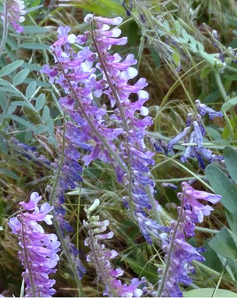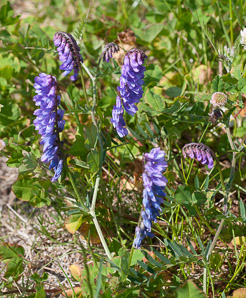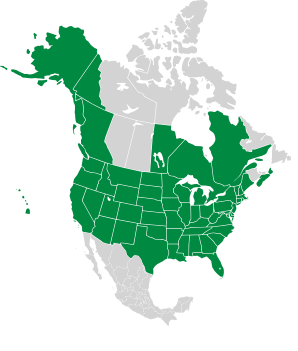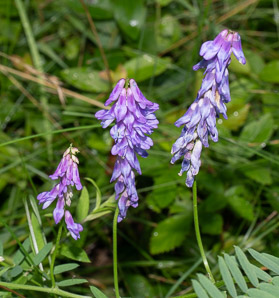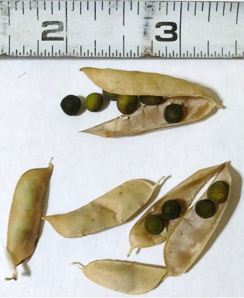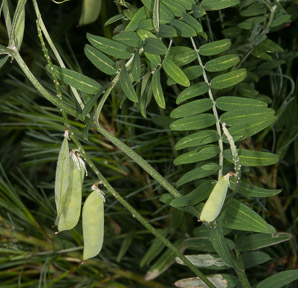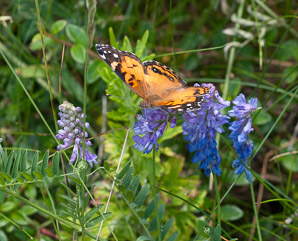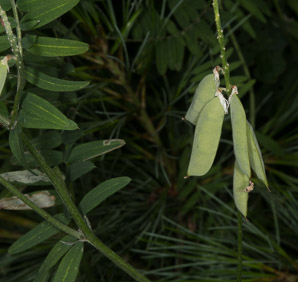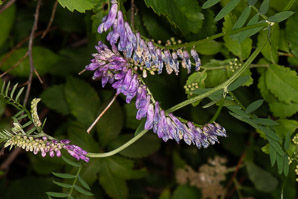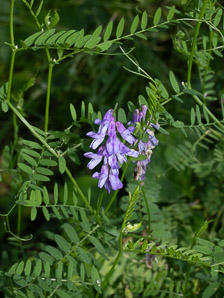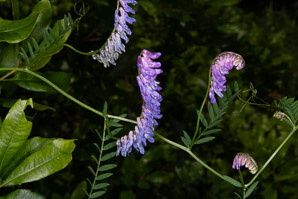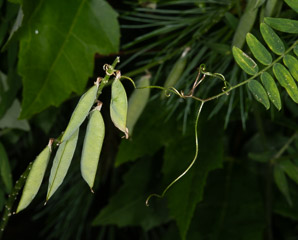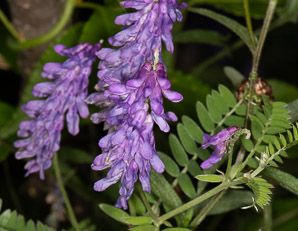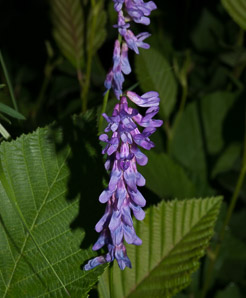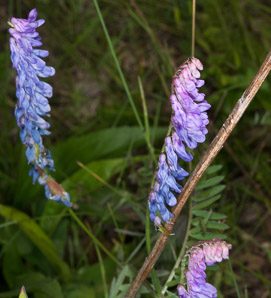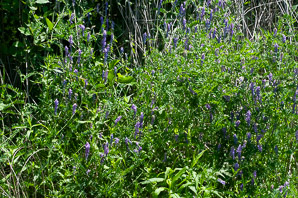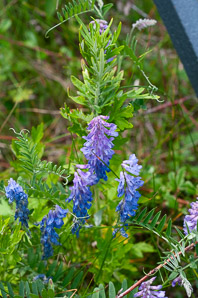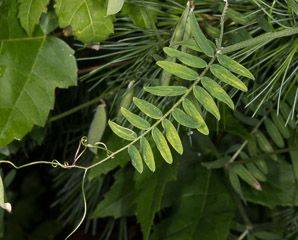
|
Vicia cracca L. Cow vetch, blue vetch, bird vetch, tufted vetch
Cow vetch is native to Europe and Asia. It was introduced to North America and other parts of the world as a forage crop. Like other legumes, its roots trap nitrogen, allowing it to grow in poor soils. The trapped nitrogen enriches meadows for foraging. It has become naturalized and is now a common sight in meadows and disturbed soils. In some areas it is an invasive. Plants: Plants can reach up to 6½′ (2 m), clambering vinelike over other plants, though they are usually lower. They have smooth or slightly hairy stems which are 4-sided. Small tendrils wrap themselves around available supports, sometimes choking other plants. Leaves: Stipules, narrow leafy pointed appendages at leaf bases, are ¼-5/16″ (6.3-8.4 mm) long. Leaves are 1-3″ (3-8 cm) long, pinnate, with 5-12 pairs of leaflets. Leaflets are linear, with needlelike tips, ⅛-⅜″ (5-10 mm) long. Flowers: Flowers are one-sided racemes with curled tips and densely spaced purple-blue to reddish-purple flowers. They appear from May to August. Fruits: Seedpods look like miniature pea pods, about ¾-⅞″ (2-2.5 cm) × ⅛″ (5 mm), with 2-8 seeds. These are closely similar: |
7/29/2023 · Saint Libory, Nebraska · By Gary Hickman 5/24/2010 · Eastern Promenade, Portland, Maine · ≈ 2½ × 1½′ (76 × 50 cm) |
||||||||||||||||||||||||||||
|
| |||||||||||||||||||||||||||||
Vicia villosa |
You are here Vicia cracca |
||||||||||||||||||||||||||||
|---|---|---|---|---|---|---|---|---|---|---|---|---|---|---|---|---|---|---|---|---|---|---|---|---|---|---|---|---|---|
| Common Name |  |
 |
|||||||||||||||||||||||||||
| Plant | Up to 3′ (91 cm), hairy, with round, ridged stems that have white hairs. Plants are heavily branched, and equipped with tendrils to clamber over other plants. | Up to 6½′ (2 m), clambering vinelike over other plants, though they are usually lower. They have smooth or slightly hairy stems. Small tendrils wrap themselves around available supports, sometimes choking other plants. | |||||||||||||||||||||||||||
| Flowers | In groups of 5-30, densely packed into a one-sided raceme. Individual flowers are ½-¾″ (1.3-1.9 cm) long, with bilateral symmetry. The flowers are tubular, bi-colored—pink to blue-purple and white, with 5 petals. The tube-shaped calyx is swollen at its base, and hairy; flower stalks are also hairy. Flowers Apr-Oct. | One-sided racemes with curled tips and densely spaced purple-blue to reddish-purple flowers. They appear from May-Aug. | |||||||||||||||||||||||||||
| Leaves | Stipules, little hairy projections at leaf bases, are less than ¼″ (6.3 mm) long. Leaves are compound, even pinnate, alternate, up to 10″ (25 cm) × 2″ (5 cm) Leaflets occur in groups of 8-20, and are narrowly oval or linear, hairy, and up to 1″ (2.5 cm) × ¼″ (6.3 mm). | Stipules, narrow leafy pointed appendages at leaf bases, are ¼-5/16″ (6.3-8.4 mm) long. Leaves are 1-3″ (3-8 cm) long, pinnate, with 5-12 pairs of leaflets. Leaflets are linear, with needlelike tips, ⅛-⅜″ (5-10 mm) long. | |||||||||||||||||||||||||||
| Fruit | Fruits resemble small pea pods, ¾-1¾″ (2-5 cm) in length. Each pod contains 2-3 round, black seeds about ⅛″ (3 mm) in diameter. | Seedpods look like miniature pea pods, about ⅜-⅞″ (1-2.5 cm) × ⅛″ (5 mm), with 2-8 seeds. | |||||||||||||||||||||||||||
| Range/ Zones |
|
|
|||||||||||||||||||||||||||
| Habitats | Fields, roadsides, and waste places, dry black-soil prairies, grassy meadows, and riverbanks. | Meadows, grasslands, disturbed soils. | |||||||||||||||||||||||||||
| Type | Wild | Wild | |||||||||||||||||||||||||||
| Occurrence | Common | Common to invasive | |||||||||||||||||||||||||||
|
Rolling your own fertilizer Nitrogen is one of the essential building blocks of all life. There is no shortage of nitrogen—it makes up almost four fifths of our atmosphere—but neither plants nor animals can use it directly in its atmospheric form (N₂). It takes energy to convert it to a usable form, for instance, to ammonia or nitrates. Energy from lightning, for example; or energy from the vast amounts of electricity used to create commercial nitrate fertilizers. If a plant could somehow harvest nitrogen directly from the air, it would be able to make its own fertilizer, allowing it to colonize soils that were too poor in nutrients for other plants. Legumes, including alfalfa, clover, peas, beans, lentils, soybeans, and peanuts, have managed exactly this stunt, called "nitrogen fixing"—and without even solving the problem themselves. Instead, they brokered an amazing agreement with the real inventors of nitrogen fixing: symbiotic bacteria known as Rhizobia. The bacteria grow in nodules on the roots of legumes, supplying the plant with usable nitrogen in return for malates and succinates for energy and carbon. The bacteria combine nitrogen, hydrogen, and electrons like this: N₂ + 8H+ + 8e– → 2NH₃ + H₂ We could write this more simply as: nitrogen + hydrogen + electricity → ammonia + hydrogen The eight hydrogen ions (8H+) in this reaction come mostly from water vapor. The electrons (8e–) can be thought of as electricity created by the bacteria. The results of the reaction include ammonia (NH₃) and hydrogen (H₂). The created hydrogen reacts pretty quickly with oxygen, forming more water vapor. And the ammonia is very close to what the plant needs. In water, ammonia quickly reacts with hydrogen ions in the water to create ammonium ions: NH₃ + H+ → NH₄+ or ammonia + hydrogen ions → ammonium ions You are already familiar with this reaction—it is the same one that makes you wrinkle your nose in disgust when you catch a whiff of ammonia. But what smells bad to you is a critical nutrient to most plants. The ammonium ions created by the bacteria are absorbed directly by the roots of the legumes. The trapped nitrogen feeds the plant, with enough left over after the plant dies to foster the growth of other plants as well. Thus legumes are sometimes called green manure. So before you get too irritated with the clover growing in your lawn, consider that it is busy fertilizing your lawn. |
Online References:
Www.jeffpippen.com (Vicia)
Discover Life (photos)
Wikimedia Commons (photos)
ARKive: Images of Life on Earth
Luirig.altervista.org (Great photos)
Invasive.org, Center for Invasive Species and Ecosystem Health
7/20/2023 · Curtis Farm Preserve, Harpswell, Maine 
7/29/2023 · Saint Libory, Nebraska · By Gary Hickman 
7/17/2019 · Oceanview, Falmouth, Maine · ≈ 6 × 4″ (16 × 11 cm) 
6/20/2010 · Blue Hill Reservation, Milford, Massachusetts · ≈ 11 × 7″ (27 × 18 cm) 
7/17/2019 · Oceanview, Falmouth, Maine · ≈ 6 × 4″ (15 × 10 cm) 
7/22/2021 · Mitchell Field, Harpswell, Maine · ≈ 7 × 4½″ (17 × 11 cm) 
Vicia cracca description by Thomas H. Kent, last updated 26 Jul 2023.
© FloraFinder.org. All rights reserved.
7/20/2023 · Curtis Farm Preserve, Harpswell, Maine 
7/18/2020 · Woodward Point Preserve, Brunswick, Maine · ≈ 8 × 5″ (20 × 13 cm) 
7/17/2019 · Oceanview, Falmouth, Maine · ≈ 6 × 4″ (15 × 10 cm) 
7/5/2021 · Curtis Farm Preserve, Harpswell, Maine · ≈ 5 × 3″ (12 × 8.4 cm) 
6/5/2013 · Nashua River Rail Trail, Groton Center, Groton, Massachusetts · ≈ 4½ × 7″ (12 × 18 cm) 
6/29/2014 · Mount Agamenticus, York, Maine · ≈ 6 × 9″ (15 × 22 cm) 
6/17/2013 · Nashua River Rail Trail, Nashoba Hospital, Massachusetts · ≈ 6 × 8″ (14 × 20 cm) 
6/5/2010 · Nashua River Rail Trail, Groton Center, Groton, Massachusetts 
6/20/2010 · Blue Hill Reservation, Milford, Massachusetts · ≈ 6 × 9″ (14 × 22 cm) 
7/17/2019 · Oceanview, Falmouth, Maine · ≈ 6 × 4″ (16 × 11 cm) 
Range:

